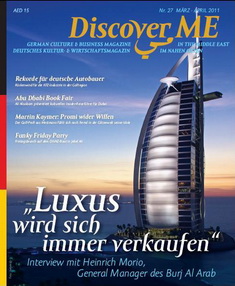
Article:
ISSUE No.3 March - April 2007
Art and Culture in Ras Al Khaimah
The Quest for National Identity and Cultural Heritage
The United Arab Emirates does not only owe its economic prosperity to the brimming oil resources but also to the millions of foreign workers who cement one project after another in the desert sand. The result of this policy is an ethnic structure which makes the locals a minority in their own country. Various cultural projects are promoted in the northern Emirate of Ras Al Khaimah to reinforce national identity and preserve the region’s cultural heritage.
The annual spring Awafi Festival is already internationally renowned for its numerous cultural highlights. This year, sports contests, traditional singing and dance performances and art exhibitions once again took place in the middle of the picturesque desert landscape. His Highness Sheikh Saud Bin Saqr Al Qasimi, Crown Prince and Deputy Ruler of Ras Al Khaimah, was optimistic about the Emirate as a touristic centre: “The success of the Awafi Festival is an initial step towards the long-term development of Ras Al Khaimah’s tourist facilities. The concept of the festival is unique in the region and offers us the opportunity to demonstrate the beauty of the landscape and the wealth of our cultural heritage.” His Highness Sheikh Faisal Bin Saqr Al Qasimi, Board Director of the RAK Finance Department and organisation director of the Awafi Festival, also refers to the Emirate’s ambitious plans: “There are currently ten hotels, resorts and other tourist projects in the realisation phase in Ras Al Khaimah. All of these projects will be completed soon and, simultaneously, the Awafi Festival should also attract tourists from all over the world during the spring season.” The “Heritage Village” serves as a permanent culture exhibition which provides an insight into the way Emiratis used to live and work. Hunting weapons, tools and every-day equipment from an era before the economic boom are exhibited with a lot of attention to detail in the countless Arab tents. They show the amazed visitors just how hard life in the desert was until only a few decades ago.
The German artist Ray Kunzmann was also enthused by the flair of the Awafi Festival and exhibited his work there. Under the motto “the best artist is nature itself“, Ray, who comes from the Ore Mountains, perfected the technique of stone collage and is regarded throughout Europe as the master of his field. His unique mosaics are made from the finest stone types from all over the world: alabaster, cara marble, sandstone, granite and mica are all used in their natural and any conceivable dyed colours. Ray Kunzmann values the practical usability of his works. In addition to the usually large-scale murals, he also makes table-tops, door panels, inlays, wall and ceiling boarding and design objects, such as signs, crests and sculptures or mosaics with ancient Roman motifs. Designed accordingly, the works of art defy almost all climatic conditions. They endure a lot of strain, e.g. in the floor or underwater, and are extremely resistant to wear and tear. For his exhibition at the Awafi Festival, he made a large-scale portrait of the President of the United Arab Emirates, His Highness Sheikh Khalifa Bin Zayed Bin Sultan Al Nahyan, using 375,000 coloured stones. His works were marvelled by Emirati and international visitors alike and are currently on show in different establishments in Ras Al Khaimah and Dubai.
One of the organisers of the Awafi Festival is Ali Abdul Rahman Darwish, who would like to contribute towards the preservation of the region’s cultural heritage. In addition to the work he does for the police, he also devotes a lot of time and effort to the development of a museum he has built on his own land. He has reconstructed authentic rooms, kitchens and bathrooms to demonstrate how the local population lives. Alongside the jewellery, clocks and toys, hunting gears and weapons can also be admired. Ali spends time with each visitor, explaining the individual items full of devotion. The passionate collector is also only too glad to show the impressed guests his menagerie of animals. The dancing parrot is a particular favourite. Ali’s fat guestbook is full of photos and dedications from delighted visitors, who not only gained an insight into Emirati culture but were also able to appreciate the Arab hospitality.
For more information on the Awafi Festival, Ray Kunzmann and the Bin Darwish Heritage Village, visit: www.rak24.com and www.al3resh.net.
